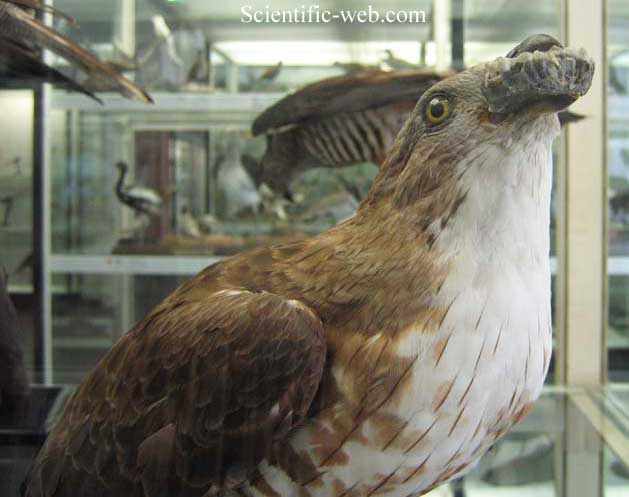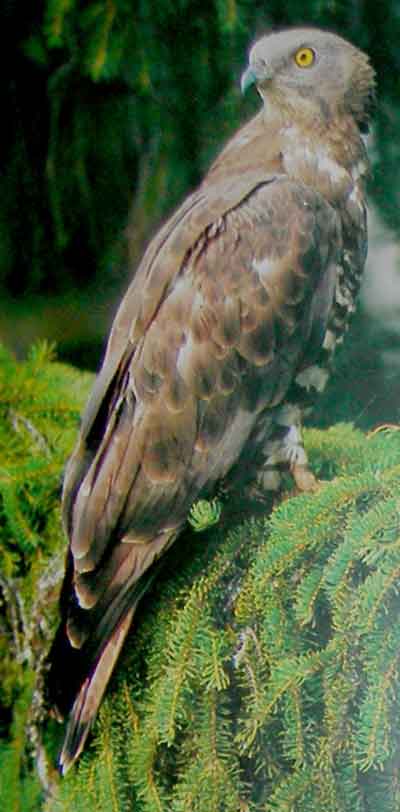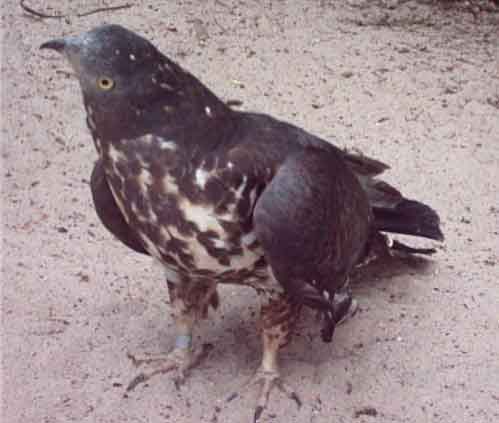Pernis apivorus , Photo: Michael Lahanas Cladus: Eukaryota
Pernis apivorus
Pernis apivorus (*) Name Pernis apivorus (Linnaeus, 1758) Reference Systema Naturae ed.10 p.91 Vernacular names The Honey Buzzard (Pernis apivorus), is a bird of prey in the family Accipitridae which also includes many other diurnal raptors such as kites, eagles and harriers. Despite its name, this species is not related to the true buzzards in the genus Buteo, and is closer to the kites. It is a summer migrant to most of Europe and western Asia, wintering in tropical Africa. It is a specialist feeder, living mainly on the larvae and nests of wasps and hornets, although it will take small mammals, reptiles and birds. It is the only known predator of the Asian giant hornet. It is thought that Honey Buzzards have a chemical deterrent in their feathers that protects them from wasp attack. The specific name apivorus means "bee-eater", although bees are much less important than wasps in its diet. The Honey Buzzard breeds in woodland, and is inconspicuous except in the spring, when the mating display includes wing-clapping. Breeding males are fiercely territorial. The 52–60-centimetre-long (20–24 in) Honey Buzzard is larger and longer winged, with a 135–150-centimetre (53–59 in) wingspan, when compared to the smaller Common Buzzard Buteo buteo. It appears longer necked with a small head, and soars on flat wings. It has a longer tail, which has fewer bars than the Buteo buzzard, usually with two narrow dark bars and a broad dark sub-terminal bar. The sexes can be distinguished on plumage, which is unusual for a large bird of prey. The male has a blue-grey head, while the female's head is brown. The female is slightly larger and darker than the male. Being a long distance migrant, the Honey Buzzard relies on magnetic orientation to find its way south, as well as a visual memory of remarkable geographical features along the way (Mountain ranges, rivers, etc.). This species follows precise migratory routes that avoid large expanses of water over which it cannot soar. Accordingly, great numbers of Honey Buzzards can be seen crossing the Mediterranean sea over its narrowest stretches, such as the Gibraltar Strait, the Bosphorus, or in Israel. The call is a clear peee-lu.
Honey Buzzard is a rare breeder and scarce migrant in Britain. Its most well-known summer population is in the New Forest, Hampshire, but it is also found in Wareham Forest (Dorset), in Swanton Novers Great Wood (Norfolk), in the Neath valleys (South Wales), in the Clumber Park area (Nottinghamshire), near Wykeham Forest (North Yorkshire) Haldon Forest Park (Devon) and at numerous other sites in Wales and Scotland. Behaviour The Honey Buzzard is seen in a wide range of habitats, but generally prefers woodland and exotic plantations. It is sometimes seen soaring in thermals. The soaring jizz is quite diagnostic; the wings are held straight with the wing tips horizontal or sometimes slightly pointed down. The head protrudes forwards with a slight kink downwards and sometimes a very angular chest can be seen, similar to a Sparrowhawk, although this may not be diagnostic. The angular chest is most pronounced when seen in direct flight with tail narrowed. When flying in wooded vegetation, Honey Buzzards usually fly quite low and perch in mid canopy, holding the body relatively horizontal with tail drooping. The bird often appears restless with much ruffling of the wings and shifting around on its perch. The Honey Buzzard often inspects possible locations of food from its perch, cocking its head this way and that to get a good look at possible food locations. This behaviour is reminiscent of an inquisitive parrot. Honey Buzzards also hop from branch to branch, each time flapping their wings once, and so emitting a loud clap. Mimicry It has been suggested that the similarity in plumage between juvenile Honey Buzzards and Common Buzzard has arisen as a partial protection against predation by Northern Goshawks. Although that formidable predator is capable of killing both species, it is likely to be more cautious about attacking the better protected Buteo species, with its stronger bill and talons. Similar Batesian mimicry is shown by the Asian Pernis species, which resemble the Spizaetus hawk-eagles References in popular culture * Angela Carter's novel, Shadow Dance prominently featured a character called Honeybuzzard. When Shadow Dance was released in the US, its title was changed to Honeybuzzard. * In the book The Surgeon's Mate by Patrick O'Brian, Dr. Maturin is presented, to his astonishment, with a cask of salted Honey Buzzards as gift from the Swedish commandant of the Gothenburg garrison, who considers them a delicacy. * An alternate name for the bird is the pern.[1] It has been argued by some (e.g., Smith[2] or [3]) that the lines "perne in a gyre" in William Butler Yeats poem Sailing to Byzantium have an alternate reading as referring to the circling flight of a honey buzzard. This conjecture is not supported by the Oxford English Dictionary which treats perne as a verb meaning "to spin".[4]
1. ^ Pern, Oxford English Dictionary * BirdLife International (2004). Pernis apivorus. 2006. IUCN Red List of Threatened Species. IUCN 2006. www.iucnredlist.org. Retrieved on 11 May 2006. Database entry includes justification for why this species is of least concern * British Birds, volume 99, March 2006 * Gensbøl, Benny (1989). Collins guide to the Birds of Prey of Britain and Europe North Africa and the Middle East, William Collins Sons and Co Ltd. ISBN 0-00-219176-8 Source: Wikipedia, Wikispecies: All text is available under the terms of the GNU Free Documentation License |
|



